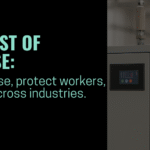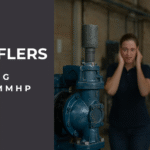In today’s industrial environments, pneumatic exhaust mufflers are essential componentsfor safe, efficient, and noise-controlled operations. They may seem like small accessories,but their impact on productivity and workplace safety is significant. Without routine inspectionand timely replacement, clogged or degraded mufflers can lead to excessive noise,increased backpressure, and even total system failure.
MMHP’s industry-leading PNEUMUFFLER® series is designed to solve these problemshead-on. But even the best pneumatic exhaust mufflers need timely maintenance andreplacement. So how often should you change them? Let’s break it down.
What Are Pneumatic Exhaust Mufflers?
Pneumatic exhaust mufflers—also referred to as silencers or air mufflers—are designed toreduce the loud noise generated by high-pressure air release from pneumatic equipment.Additionally, they help filter out oil mist, dust, and debris, improving both system performanceand environmental safety.
MMHP’s PNEUMUFFLER® series delivers superior performance by combining robustconstruction with advanced filtration technology. These mufflers are compatible with globalthread standards (BSP/NPT) and are built to last under harsh industrial conditions.
Why MMHP’s PNEUMUFFLER® Stands Out
When selecting pneumatic exhaust mufflers, performance, durability, and compatibility matter. MMHP’s PNEUMUFFLER® line is manufactured in India to ISO 9001:2015 and ISO 14001:2015 standards and offers:
Noise reduction ≤ 80 dB at 1 meter
Filtration of particles as small as 5 microns
High compatibility with BSP/NPT threads
Compact, easy-to-install design
Available in custom sizes
Designed for various industrial climates
Whether you’re running air compressors, marine systems, or PET bottling lines, MMHP has the right pneumatic exhaust mufflers for your needs.
Available Variants of PNEUMUFFLER®
1. Standard Series
These general-purpose pneumatic exhaust mufflers provide excellent noise reduction and filtration for most industrial applications.
- Noise Reduction: ≤ 80 dB
- Pressure Capacity: up to 15 Bar
- Long-lasting, maintenance-free
- Available in multiple sizes with male/female threads
2. High-Pressure Series
Designed for environments with high exhaust pressure, these mufflers combine durability with high performance.
- Pressure capacity: up to 40 Bar
- Heavy-duty metal body
- Optional relief valve
- Compact and robust
3. Relief Valve Series
These pneumatic exhaust mufflers include a built-in relief valve to automatically release excess pressure—enhancing safety.
- Pressure: up to 15 Bar
- Ideal for PET bottling and blow molding systems
- Reduces risk of accidents and unplanned downtime
Applications for Pneumatic Exhaust Mufflers
MMHP’s PNEUMUFFLER® series is trusted across a wide range of sectors:
- Air Compressors & Dryers
- Nitrogen/Oxygen Generators
- Marine Pneumatic Systems
- AODD Pumps
- Spray Painting Systems
- Hoists and Pneumatic Tools
- PET Bottling & Blow Molding
Whether your environment is clean or rugged, indoors or exposed, MMHP’s pneumatic exhaust mufflers deliver consistent performance.
Why and When to Replace Pneumatic Exhaust Mufflers
Over time, even the best pneumatic exhaust mufflers accumulate carbon, oil, and fine dust. A clogged muffler can:
- Increase exhaust noise
- Reduce actuator speed
- Cause system backpressure
- Trigger equipment failure or downtime
Replacement Guidelines
| Environment | Suggested Replacement |
| Clean Room Use | Every 9–12 months |
| Light Industrial Use | Every 4–6 months |
| High-Dust/Oil Settings | Every 1–3 months |
| 24/7 Operations | Inspect monthly |
Replacing pneumatic exhaust mufflers before failure keeps your systems running smoothly and reduces costly downtime.
How to Know It’s Time to Replace
If you notice any of the following, your pneumatic exhaust mufflers may need replacement:
- Increased noise levels
- Slower cylinder actuation
- Visible clogging or blackening
- Unusual backpressure readings
- Airflow diagnostics triggering alerts
In mission-critical systems, monthly inspections are recommended.
Can You Clean Pneumatic Exhaust Mufflers?
For MMHP’s sintered bronze models, light cleaning is possible:
- Remove the muffler carefully.
- Soak in a safe solvent to dissolve oil and residue.
- Blow air through the muffler in reverse direction.
- Let it dry fully before reinstalling.
However, cleaning only restores partial functionality. Full replacement ensures maximum performance and safety.
Maintenance Tips
To extend the lifespan of your pneumatic exhaust mufflers, follow these tips:
- Maintain a replacement log based on operating hours.
- Stock spare mufflers for each system size.
- Train technicians to spot early signs of clogging.
- Choose the right muffler variant based on pressure and application.
MMHP offers both standard and custom solutions for every scenario.
Why Industry Trusts MMHP
MMHP is known across India and beyond for its commitment to excellence. Here’s why customers choose MMHP’s pneumatic exhaust mufflers:
- High performance under pressure
- Custom sizes and solutions
- Fast delivery and local support
- Affordable without compromising quality
- Manufactured under globally certified processes
Every MMHP pneumatic exhaust muffler is built for performance, value, and peace of mind.
Final Thoughts
Your system’s performance, noise control, and longevity depend on small but vital components like pneumatic exhaust mufflers. Routine replacement of these mufflers—especially with high-quality options like MMHP’s PNEUMUFFLER® series—ensures smooth operations and a safe workplace.
Don’t let a clogged muffler disrupt your production. Inspect monthly, replace regularly, and choose MMHP for trusted quality and reliability.





